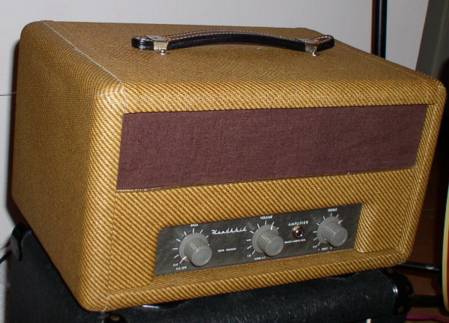Hi there-- I've been reading the threads here for a while, and it's time to dig in on a project of my own. Hopefully I can get some ideas from the collective experience here.
I just got a Heathkit A-7E, and the build (circa 195?) was so horrific I had to gut it. I tried to mod an old Bell 2122-C hi-fi a bit ago, got in over my head, and made a mess. I figure I'll go back and fix it when I know more about circuit design and have polished my soldering skills. Anyway, I thought that was ugly, till I turned this A-7 over and looked at the wiring job! I'll bet it never worked, and possibly killed the guy who first plugged it in!
So I'm down to a couple trannies and some solid tube sockets. It's got 12V heater taps, and all octal sockets, and I'm thinking of building something based on an early Fender Deluxe design (push-pull, 5y3 rectifier). I know they used 6.3V heater tubes (6SC7s, 6SL7s, 6V6s). I'm not really trying to copy a Fender circuit, just use a similar tube complement/layout/circuit plan.
So here are my questions for you guys:
how hard is it to get the 12V equivalents to those tubes?
Are they around? NOS only?
Are they actually equivalents to the 6.3V tubes (in terms of plate voltages, current and etc.)?
And-- how far would you need to deviate from this schematic to create an amp that does right by electric guitar? I assume I'll need a different tone stack (maybe a fixed mid). In terms of tone, I am open to different sounds, but want to be able to push into sweet distortion.
What would you do to this, given the trannies I have, the 12V needs, and the octal sockets I'd like to keep?
Here's a link to the A-7E schematic on the Audiophool site: http://www.audiophool.cjb.net/Schem_A/Heath_A7.gif
Thanks in advance for any suggestions!
--colin
I just got a Heathkit A-7E, and the build (circa 195?) was so horrific I had to gut it. I tried to mod an old Bell 2122-C hi-fi a bit ago, got in over my head, and made a mess. I figure I'll go back and fix it when I know more about circuit design and have polished my soldering skills. Anyway, I thought that was ugly, till I turned this A-7 over and looked at the wiring job! I'll bet it never worked, and possibly killed the guy who first plugged it in!
So I'm down to a couple trannies and some solid tube sockets. It's got 12V heater taps, and all octal sockets, and I'm thinking of building something based on an early Fender Deluxe design (push-pull, 5y3 rectifier). I know they used 6.3V heater tubes (6SC7s, 6SL7s, 6V6s). I'm not really trying to copy a Fender circuit, just use a similar tube complement/layout/circuit plan.
So here are my questions for you guys:
how hard is it to get the 12V equivalents to those tubes?
Are they around? NOS only?
Are they actually equivalents to the 6.3V tubes (in terms of plate voltages, current and etc.)?
And-- how far would you need to deviate from this schematic to create an amp that does right by electric guitar? I assume I'll need a different tone stack (maybe a fixed mid). In terms of tone, I am open to different sounds, but want to be able to push into sweet distortion.
What would you do to this, given the trannies I have, the 12V needs, and the octal sockets I'd like to keep?
Here's a link to the A-7E schematic on the Audiophool site: http://www.audiophool.cjb.net/Schem_A/Heath_A7.gif
Thanks in advance for any suggestions!
--colin

Comment